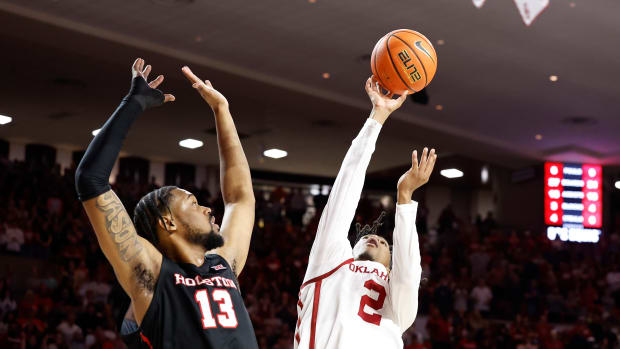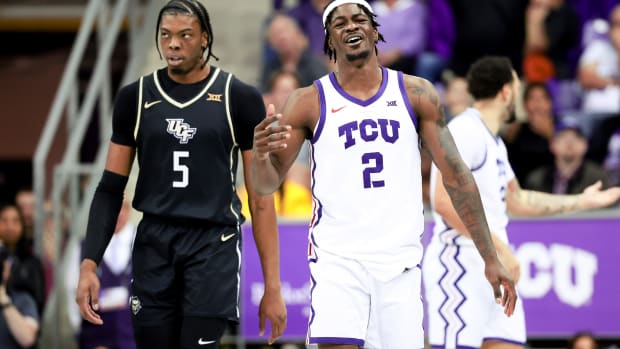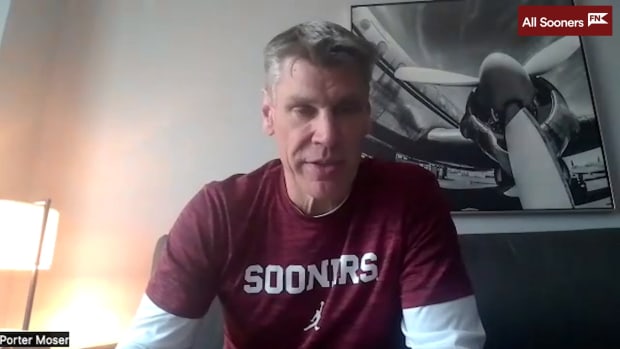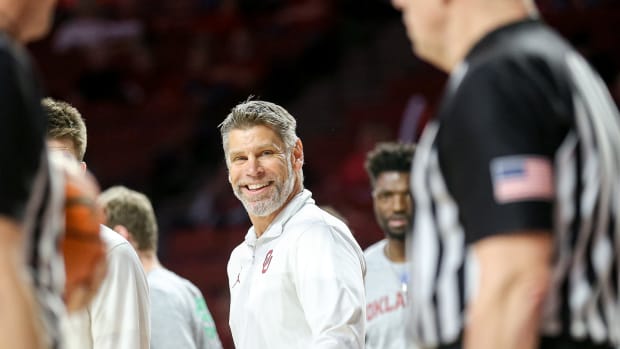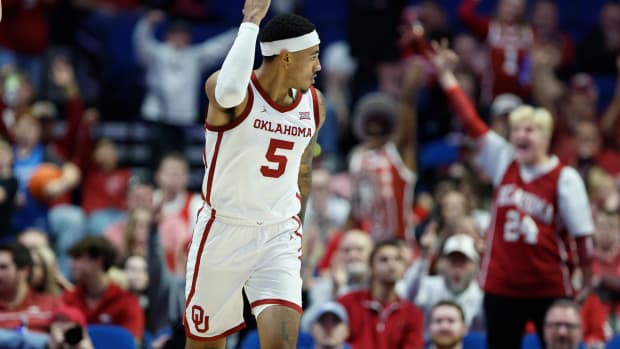COLUMN: Oklahoma’s Unpredictable Chemistry was Costly in NIT Loss
NORMAN — Maybe Porter Moser’s rebuilding job in 2022 was always going to be just a little too big.
With five frontline arrivals via the transfer portal and three freshmen needing to make contributions this season, the Oklahoma basketball team could never quite capture the kind of flow and chemistry that a team needs to produce a great basketball season.
Too many losses in Big 12 Conference play meant a trip to the NIT, rather than the NCAA Tournament.
And it’s there, in the nether regions of college basketball’s postseason — in the cozy confines of OU’s very own Lloyd Noble Center, no less — after another night of disjointed basketball that the Sooners’ season came to an end.
Sunday night, in a second-round NIT game against St. Bonaventure, top-seeded OU lost 70-68 to a more experienced Bonnies squad.
The Sooners finished the season 19-16, while St. Bonaventure advances at 22-9.
"We asked so much of this group," Moser said. "You know, new coaching staff, new teammates coming together."
A quick peek around the nation this season shows how much work Moser and the Sooners had to do: Alondes Williams transferred to Wake Forest and became the ACC Player of the Year. Kam McGusty transferred out a couple years back and was first-team All-ACC at Miami. Brady Manek got All-ACC honors as well and has fueled North Carolina's late-season surge. And in the Pac-12, De’Vion Harmon had another good season, bu this time at Oregon.
That’s a lot of talented guys who played together in Norman under Lon Kruger doing good work for other schools.
Moser, too, had good talent this season. He just didn’t have quite enough time to mix it all together. Whether it was extended offensive droughts or stark defensive lapses, confusion on inbounds passes or conflicts in calling out defenses, it seemed each game brought some new level of inconsistency, some additional level of incoherence.
Many times, it seemed like Moser and his staff just had a hard time defining roles for the five on the floor. Scoring often came from everywhere, and too often from nowhere.
Moser had expressed concern — or maybe it was admiration, possibly a touch of envy — over the Bonnies’ starting five: five seniors, four of them St. Bonaventure lifers, the other a three-year Bonnie after a year in junior college.
And the Bonnies’ essentially five-man rotation — fresh off a cross-country trip from New York to Colorado, followed by a trip to Norman — overcame low numbers and jet lag and played with the kind of savvy, poise and togetherness that can take a team places in the postseason.
Four of the five played 40 minutes on Sunday night. The other played 34.
And yet, Jaren Holmes (23 points), Osun Osunniyi (14), Jalen Adaway (11) Kyle Lofton (10) and Dominick Welch (10) each scored in double figures, outshot the Sooners 51 percent for 47 and outshot them from deep 53 percent to 42.
"They’re just resilient," Moser said. "You watched ‘em go to Colorado. Think about that trip. They found out Sunday night they had to go to Colorado, they leave the next day and play in the altitude on Tuesday and beat Colorado — with five guys. In the altitude. It’s a resilient group, and you’ve got to take your hat off to that.
"When you’ve got that kind of seniors that have been through it — you know, NCAA team last year, then they missed out on it, they go to Colorado, then they turn right around and came to Oklahoma."
Meanwhile, Moser has five Division I transfers in Jordan Goldwire (Duke), Marvin Johnson (Eastern Illinois), Ethan Chargois (SMU), and brothers Tanner and Jacob Groves (Eastern Washington), plus two starters who transferred last year in Mo Gibson and Elijah Harkless.
Toss in freshmen Bijan Cortes, C.J. Noland and Alston Mason — on top of an all-new coaching staff — and Oklahoma was fighting an uphill battle night in and night out.
"I still think we had our chances," Moser said. "We fought back. We had some ill-advised turnovers. I thought we hit a lot of shots. We just — we didn’t capitalize on the opportunities we had, and they capitalized on some of the opportunities they had.
"It was our eighth game that we had a shot to win it at the end, and we didn’t."
Maybe the Sooners would have landed an NCAA Tournament bid if Harkless hadn’t been injured. Or maybe they’d have survived the Bonnies and advanced to an NIT quarterfinal matchup with Virginia with their defensive stopper and heart-and-soul on the floor.
Or maybe not. Maybe it was just too many empty possessions early, or too many missed shots late, or too many turnovers from one possession to the next.
It’s likely that 2-8 stretch in January and early February was too much for the NCAA Selection Committee to overlook. And it’s likely that Mark Schmidt’s Bonnies roster was just too experienced, too mature and too together for the Sooners to overcome.
Just like the regular season, Sunday provided plenty of highlights. The Sooners outrebounded the Bonnies 29-27 and had more assists, 19-10. OU, at times, played pretty basketball.
Chargois’ passing changed the early stages of the game. Gibson’s deadeye shooting was inspiring. A couple of defensive stops — the dive-to-the-floor-and-fast-break-pass-it kind — produced scintillating dunks.
Ultimately, though, Moser and the Sooners can now push the reset button on 2022.
Goldwire, Chargois and Johnson concluded their college careers on Sunday night. But the Groves Brothers have said they’re coming back next year. So has Harkless. The coaching staff now awaits word from Gibson on his future.
Expect more transfer arrivals next season. It’s the way of the world in college sports now. The portal is always open. But adding transfers doesn't solve every team's problems.
"It's hard," Moser said. "Anyone who ever transferred understands this. It's not easy."
The difference in the future, Moser hopes, is that with enough of this year's transfers back for next year, rejoining a coaching staff with which they’re familiar, team chemistry shouldn’t be a problem in the future.



